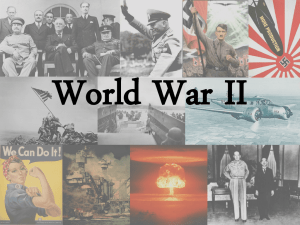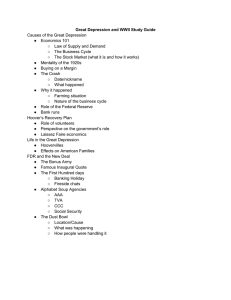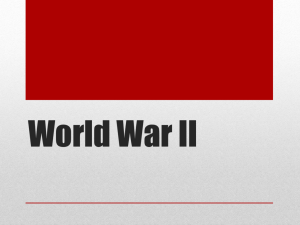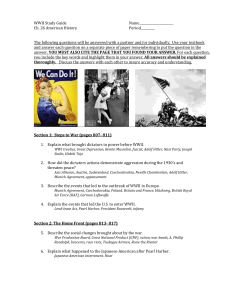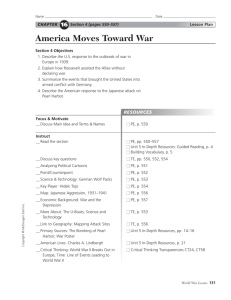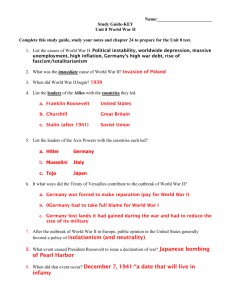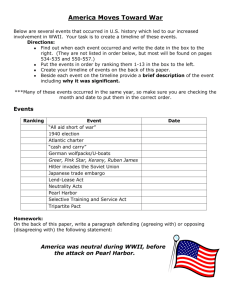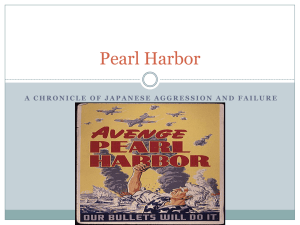11.7.14_uswwii
advertisement
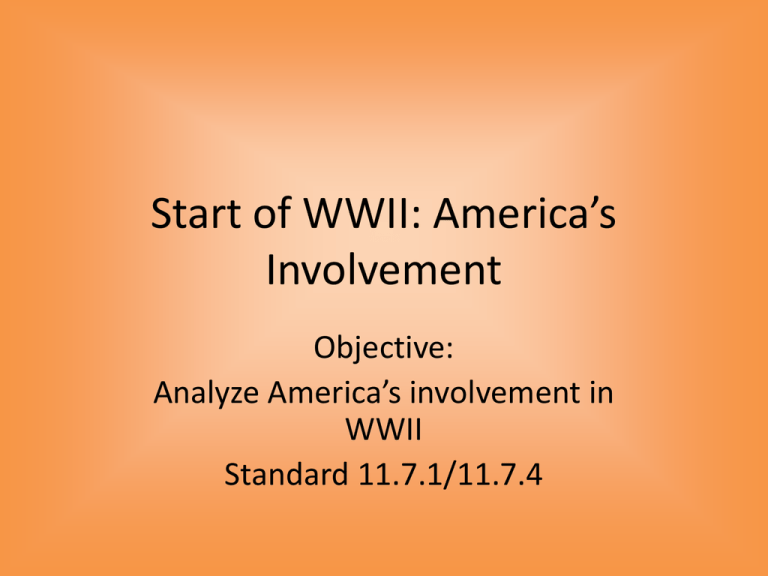
Start of WWII: America’s Involvement Objective: Analyze America’s involvement in WWII Standard 11.7.1/11.7.4 Prior Knowledge Importance • Prior to United States entry into World War II, Congress passed the Cash-and-Carry Act of 1939 and the Lend-Lease Act of 1941. These foreign policy actions showed that the United States – gave equal support to both the Allied and Axis Powers – attempted to contain the spread of communism – maintained a strict policy of isolationism – became increasingly drawn into the war in Europe Germany Objective: Analyze America’s involvement in WWII Post WWI - Germany • crushed due to war and to the Treaty of Versailles • Made Germany weak – – – – Lost Colonies Lost industrial centers Lost Army Must accept the blame for WWI Germany • Fined Germany $6 billion over a 50 year period • For a total of $60 billion. Treaty of Versailles "Only National Socialism will free Germany from the lie of sole guilt!" The negative influence of the Treaty of Versailles can be seen clearly in the first three points of the NAZI Party Platform: 1. We demand the union of all Germans in a Great Germany on the basis of the principle of self-determination of all peoples. (Refer to the map) 2. We demand that the German people have rights equal to those of other nations; and that the Peace Treaties of Versailles and St. Germain shall be abrogated (ended). 3. We demand land and territory (colonies) for the maintenance of our people and the settlement of our surplus population. The Nazi’s and Adolf Hitler use the common disgust over the Treaty and poor economic conditions in Germany to build up support of their party Old Imperial Cross incorporated into the new Nazi German flag. This was supposed to remind Germans of the past when they were strong. The Nazi’s Begin to Rebuild the German Empire • Rhineland, March, 1936 • Germany and Austria united, March, 1938 • Anschluss • Sudentenland annexed (added) to Germany, October, 1938 • Czechoslovakia , March, 1939 Appeasement and the Munich Conference • Britain and France were preparing for war • Mussolini called for a meeting to settle the issue • Britain, France, Italy and Germany met in Munich to decide the fate of Czechoslovakia – the Czechs were not invited • British Prime Minister Neville Chamberlain British Prime Minister, Neville Chamberlain – believed that by giving in to Hitler, War would be avoided – this policy is called appeasement • Hitler promised to be satisfied with the Sudetenland • In less than six months, Hitler occupied the rest of Czechoslovakia Nazis and Soviets at Peace? • In August of 1939, Hitler and Stalin signed a public 10 year Nonaggression Pact promising not to attack one another. Secretly: • Poland was divided between the two. • Lithuania, Latvia, Estonia and Finland are given to the Soviet Union for future conquest • Now Germany only has to worry about a single front (the West) • Germany invaded Poland one week later. France and England declared war on Germany two days after that (Sept. 3, 1941) The Blitz Continues • Germany invaded Holland, Belgium and Luxembourg in April, 1940 • The French relied on the strong Maginot Line in its center and right flank… – An 87 mile long series of forts with tank traps, barbed wire, 10 ft thick concrete walls, huge gun towers, underground bunkers • The British Army helped out in the West Italy Objective: Analyze America’s involvement in WWII Italy Expands • Jealous that Hitler has gain so much without firing a shot • Kicked out King Zog of Albania (one of the poorest nations in Europe), became a part of Italy Mussolini attacks Ethiopia, 1935-36 • Ethiopian army was no match for Italian tanks, airplanes and poison gas • Haile Selassie, Emperor of Ethiopia, asks League of Nations for help • League (League of Nations) does next to nothing, Selassie warns “It is us today. It will be you tomorrow.” Japan Objective: Analyze America’s involvement in WWII Japan’s Democracy Fails • 1920s Japans signed agreements to not use war as a policy tool • But Japan’s Government had little control over the military • Government was blamed for depression and military leaders took control of the nation • Many Japanese wanted control to go back to their Emperor Emperor Hirohito Japan 1930s • Ultra-Nationalistic • Militaristic • Wanted to conquer neighbors (China) to end economic crisis • Wanted room for the Japanese people at the expense of others • Asia for Asians Japan Expands • Invaded Manchuria and set up a Puppet Government, 1932 • Rich in Coal and Iron • League of Nations protested this violation of international peace but did nothing to stop Japan • 1933 Japan withdrawals from the League of Nations Japanese Aggression • Manchuria, Northern China, 1932 • China, 1936-1937 • South Asia, 1942 The Rape of Nanking • Japan absolutely brutalized China • 10’s of thousands of women raped and mutilated • Japanese officers had beheading contests • Mass executions • Hundreds of thousands of dead within a year • Don’t look at the following slides if you are squeamish America Objective: Analyze America’s involvement in WWII -Americans did not want anything to do with European wars. - Great Depression caused own own problems - Believed in Isolationism In the late 1930s, the U.S. passed three Neutrality Acts 1st NA, banned weapons sales to fighting nations 2nd NA, banned loans to fighting nations 3rd NA, permitted trade in nonmilitary goods as long as the nations paid cash and transported them • Congress passes 4th Neutrality Act – Repeals arms embargo against France & England Steps to War Steps to War This Act was later amended to allow U.S. ships to take the goods to Europe Loans and credit were still illegal In Sept 1940, the U.S. traded 50 old destroyers to Britain in exchange for permission to build bases on British territory in the Western Hemisphere Steps to War That same month (Sept 1940), Congress passed the first peacetime draft in the nation’s history In January 1941, FDR proposed to provide war supplies to Great Britain without any payment in return Lend-Lease Later on, significant aid to Russia was also given “If your neighbor’s house is on fire, you don’t sell him a hose. You lend it to him and take it back after the fire is out.” 4 Freedoms Speech • Proposed four fundamental freedoms that people "everywhere in the world" ought to enjoy: – Freedom of speech and expression – Freedom of religion – Freedom from want – Freedom from fear Japan’s Gamble: Pearl Harbor • US stated that Japan must withdraw from China or risk war • US cuts off all supplies of resources (tin, rubber, oil) to Japan and encouraged other countries to do the same • Japan was unwilling to give up land that it had conquered in the past 4 years, decided to attack the US first • Most experts believed that the attack would be centered at the Philippines. • Japan sent 60 ships, including 6 aircraft carriers, and 360 airplanes, 3,000 miles to attack Pearl Harbor, Hawaii “A day that will live in infamy” • Early December 7th, 1941 a surprise Japanese attack struck the US Pacific Fleet anchored in Pearl Harbor, Hawaii • Two waves of Japanese planes wreaked havoc and sunk or damaged 18 ships (including 8 battleships), 188 airplanes and killed 2,400 sailors and wounding over 1,100 • Luckily, the aircraft carriers were out on maneuvers and were not hit • Roosevelt then asked Congress to declare war on Japan. Germany was Japan’s partner, so now the U.S. was also at war with Germany. Closure • Which of the following events during World War II brought the United States into the war? – The D-Day invasion of Normandy. – Germany's invasion of Poland. – Japan's bombing of Pearl Harbor. – Nazi Germany's treatment of the Jewish people. Closure • The actions of which country finally forced the United States to enter the war? – Italy – Japan – Germany – The Soviet Union Closure • Which of the following statements most accurately reflects Roosevelt's feelings toward joining the war? – He agreed with the isolationists and promoted an isolationist policy. – He wanted to help the Allies but had to appease U.S. citizens who opposed entering the war. – He wanted to avoid the war because he did not see it as a threat to the United States. – He did not understand the position of isolationists and was eager to join the war. Closure • Which statement best describes the relationship between the United States and Japan at the time of the attack on Pearl Harbor in 1941? – Their ships had engaged in several naval battles in the Pacific. – They did not have diplomatic relations and had not formally talked for several years. – They shared control of military bases on the island of Midway. – Diplomats on both sides had agreed to talk to avoid conflict. Importance • Prior to United States entry into World War II, Congress passed the Cash-and-Carry Act of 1939 and the Lend-Lease Act of 1941. These foreign policy actions showed that the United States – gave equal support to both the Allied and Axis Powers – attempted to contain the spread of communism – maintained a strict policy of isolationism – became increasingly drawn into the war in Europe Closure • President Roosevelt is telling the free world that America – will enter the war. – stay out of the war until they are attacked. – will provide the weapons to protect freedom and democracy. – remain completely isolated from WWII. Closure • Why was the United States called the “arsenal of democracy” in 1940? – The leaders in the democratic nations of Europe were educated in the United States. – Most of the battles to defend worldwide democracy took place on American soil. – The United States supervised elections in European nations before the war. – The United States provided much of the weaponry needed to fight the Axis powers. Closure • President Franklin D. Roosevelt's goal in supporting the Lend-Lease Act of 1941 was to – encourage Japanese Americans to relocate voluntarily. – use foreign investment as a way of stimulating the American economy. – assist Britain's war effort without violating United States neutrality laws. – maintain an isolationist stance by providing only limited aid to both sides in the European conflict.

